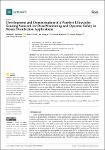Development and Demonstration of a Wireless Ultraviolet Sensing Network for Dose Monitoring and Operator Safety in Room Disinfection Applications
| dc.contributor.author | Cullinan, MF | |
| dc.contributor.author | Scott, R | |
| dc.contributor.author | Linogao, J | |
| dc.contributor.author | Bradwell, H | |
| dc.contributor.author | Cooper, L | |
| dc.contributor.author | McGinn, C | |
| dc.date.accessioned | 2023-03-20T12:29:58Z | |
| dc.date.available | 2023-03-20T12:29:58Z | |
| dc.date.issued | 2023-02-23 | |
| dc.identifier.issn | 1424-8220 | |
| dc.identifier.issn | 1424-8220 | |
| dc.identifier.other | ARTN 2493 | |
| dc.identifier.uri | https://pearl.plymouth.ac.uk/handle/10026.1/20600 | |
| dc.description.abstract |
<jats:p>The use of mobile ultraviolet-C (UV-C) disinfection devices for the decontamination of surfaces in hospitals and other settings has increased dramatically in recent years. The efficacy of these devices relies on the UV-C dose they deliver to surfaces. This dose is dependent on the room layout, the shadowing, the position of the UV-C source, lamp degradation, humidity and other factors, making it challenging to estimate. Furthermore, since UV-C exposure is regulated, personnel in the room must not be exposed to UV-C doses beyond occupational limits. We proposed a systematic method to monitor the UV-C dose administered to surfaces during a robotic disinfection procedure. This was achieved using a distributed network of wireless UV-C sensors that provide real-time measurements to a robotic platform and operator. These sensors were validated for their linearity and cosine response. To ensure operators could safely remain in the area, a wearable sensor was incorporated to monitor the UV-C exposure of an operator, and it provided an audible warning upon exposure and, if necessary, ceased the UV-C emission from the robot. Enhanced disinfection procedures could then be conducted as items in the room could be rearranged during the procedure to maximise the UV-C fluence delivered to otherwise inaccessible surfaces while allowing UVC disinfection to occur in parallel with traditional cleaning. The system was tested for the terminal disinfection of a hospital ward. During the procedure, the robot was manually positioned in the room by the operator repeatedly, who then used feedback from the sensors to ensure the desired UV-C dose was achieved while also conducting other cleaning tasks. An analysis verified the practicality of this disinfection methodology while highlighting factors which could affect its adoption.</jats:p> | |
| dc.format.extent | 2493-2493 | |
| dc.format.medium | Electronic | |
| dc.language | en | |
| dc.publisher | MDPI AG | |
| dc.subject | disinfection robot | |
| dc.subject | IOT sensor | |
| dc.subject | healthcare | |
| dc.subject | bluetooth low energy (BLE) | |
| dc.subject | ultraviolet (UV) disinfection | |
| dc.subject | safety | |
| dc.subject | wearable | |
| dc.title | Development and Demonstration of a Wireless Ultraviolet Sensing Network for Dose Monitoring and Operator Safety in Room Disinfection Applications | |
| dc.type | journal-article | |
| dc.type | Article | |
| plymouth.author-url | https://www.ncbi.nlm.nih.gov/pubmed/36904695 | |
| plymouth.issue | 5 | |
| plymouth.volume | 23 | |
| plymouth.publisher-url | http://dx.doi.org/10.3390/s23052493 | |
| plymouth.publication-status | Published online | |
| plymouth.journal | Sensors | |
| dc.identifier.doi | 10.3390/s23052493 | |
| plymouth.organisational-group | |Plymouth | |
| plymouth.organisational-group | |Plymouth|Research Groups | |
| plymouth.organisational-group | |Plymouth|Faculty of Health | |
| plymouth.organisational-group | |Plymouth|Faculty of Health|School of Nursing and Midwifery | |
| plymouth.organisational-group | |Plymouth|Research Groups|Institute of Health and Community | |
| plymouth.organisational-group | |Plymouth|Users by role | |
| plymouth.organisational-group | |Plymouth|Users by role|Academics | |
| dc.publisher.place | Switzerland | |
| dcterms.dateAccepted | 2023-02-20 | |
| dc.date.updated | 2023-03-20T12:29:28Z | |
| dc.rights.embargodate | 2023-3-21 | |
| dc.identifier.eissn | 1424-8220 | |
| dc.rights.embargoperiod | 2023-03-21 | |
| rioxxterms.versionofrecord | 10.3390/s23052493 |


